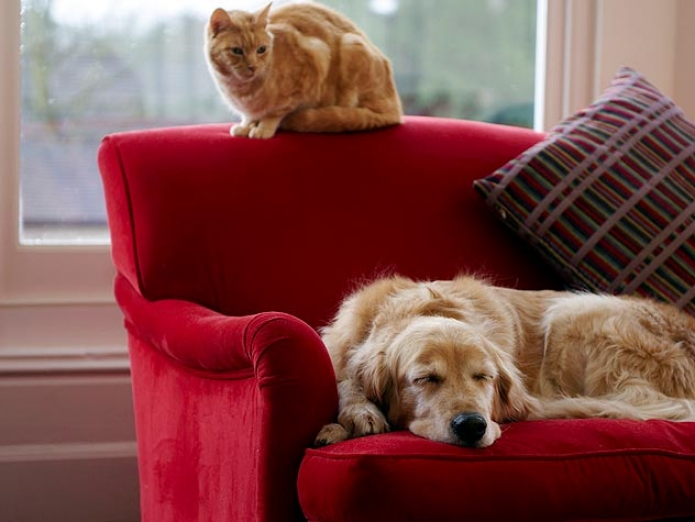
Rental dramas: 6 ways to reverse pet-related damage
Renting in Australia when you have pets can be difficult. Some renters end up paying an additional pet bond to their landlord to be able to rent with their pets. Some renters will even keep their pet in their home without telling the landlord, which is not recommended.
Most pets will cause some kind of damage to a rental property and it’s the tenant’s job to fix this before they move out.
Here are a few pet damage scenarios with solutions of how you can fix them.
1. Pet smell
Eau de wet cat or other pet smells can linger in the carpet. Start by moving all your furniture and give the house a really thorough vacuum. While you’re vacuuming, remove any soft furnishings like cushion covers, couch covers and fabric blinds and wash them in the washing machine, then leave them to dry in the sun.

Pet smells need to be removed from carpet before you move out.
Buy a big box of bi-carb soda and sprinkle it all over the carpet. Allow the baking soda to absorb the moisture and smells from your carpet for about 15 minutes and then vacuum it up.
It’s unlikely that the bi-carb soda will damage the carpet, but it might be a good idea to do a spot test first to make sure it won’t stain or damage the fibres.
2. Carpet stains
If the stain is fresh, use paper towel to soak up excess liquid. Then mix a fifty percent white vinegar and fifty percent water solution. Use a spray bottle to spray the area until it’s soaking. Use a scrubbing brush to gently work the solution into the carpet.
Use brushes carefully on your carpets as stiff bristles can cause further damage. Use more paper towel to soak up your vinegar/water solution. Once the spot is dry, sprinkle with bi-carb soda and leave for 15 minutes. Then vacuum the bi-carb soda.
You can repeat this process as necessary until the stain has been completely removed. If it’s a particularly stubborn stain, you can use a commercial carpet cleaning product. Just make sure to do a test patch on the carpet before you do the whole floor to make sure it doesn’t stain or damage the carpet.
3. Lawn damage
This is a tricky one to handle as renters won’t always be aware of when the dog or cat uses the lawn to urinate, especially if pets spend most of their time outdoors. If you do see your dog urinate on the lawn, the best course of action is to rinse the area thoroughly with water. This will dilute the ammonia and will reduce the affect it have on the grass.

Try to make sure the lawn looks even by constantly tending it if your pet lives outside.
For areas that are already dead and browning, just remove the dead patches of grass with a shovel and discard it. Then add fresh soil and compost and re-seed the area. It’s best to do this regularly so the lawn doesn’t look patchy when moving out.
4. Wood flooring
A good polyurethane seal on floors is the best defence against urine stains and surface scuffs, but it won’t fully protect the wood. If there are surface-level scratches, visit your local hardware and ask for some DIY options.
There are kits with small pots of stain you can use to fix minor damage and these are available at hardwood stores or flooring specialist stores.

Consider hiring a professional to fix wood floor damage caused by a pet.
For deeper scratches, the floor will need to be repaired with wood filler and sanded down. It’s best to leave this until right before moving out, to save money and time as pets will inevitably scratch the wood again.
It’s also important to make sure that in fixing the floor no further damage is created. If you’re not sure what to do, hire a professional to do it for you.
5. Chew damage
Dogs and even cats love to chew things, particularly cabinet handles, skirting boards and pieces of loose linoleum. The best thing to do in these circumstances is to replace them.
If similar replacement for cabinet handles can’t be found, then replace them all. This also applies to linoleum and skirting boards.

It’s important that the handles all match.
Be honest with your landlord and ask if they have any excess linoleum or carpet squares that you can use to replace the damage. Many homeowners keep scrap building materials for this purpose.
6. Walls
If your pet has chewed on a wallpapered wall, there’s not a lot you can do, unless you have some of the left over wallpaper handy. If the wall is made of gyprock or panelling, you can sand the area to clear away ragged edges and to get the damage clean for a repair job.
Go to your local hardware store and ask for the best commercial filler to use and fill any gaps in the wall. Once you’ve filled the gaps, just sand it back, and cover it with primer and matching paint.
Bad repair jobs look really obvious and can be expensive to fix. So do it well yourself or hire a professional.
Source: Carly Jaccobs, 18 May 2016, realestate.com.au
